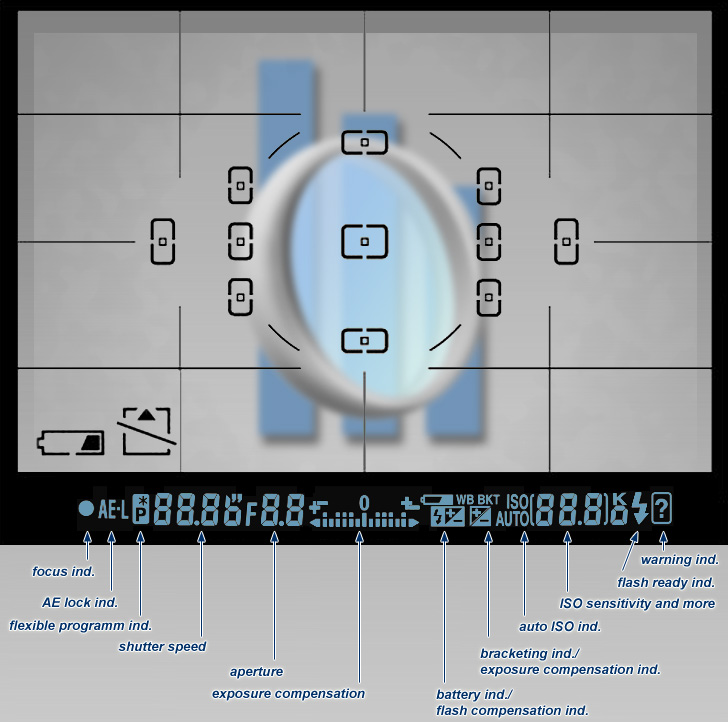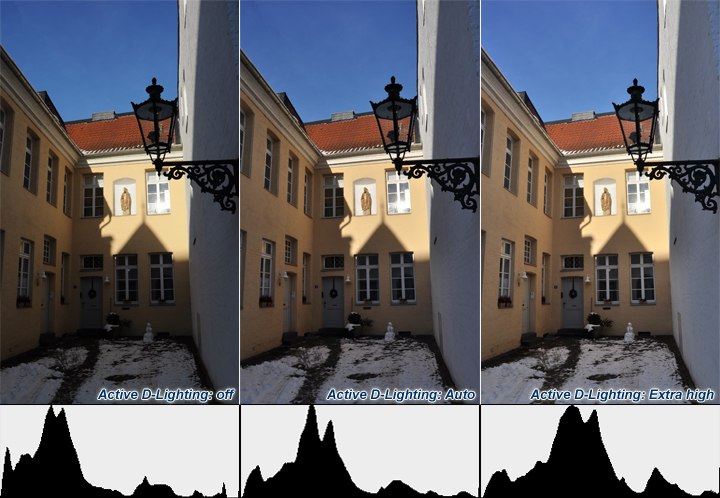|
Page 2 of 7
General 

Body Quality
Upon the first contact you can notice the comparatively high build quality of the Nikon D5000 - it does not creak or rattle. The construction is based on a high quality plastic shell on an internal metal structure. The grip is well rubberized while there is insufficient rubber for the thumb-rest on the back just below the command dial. Nevertheless average-sized hands should have no problems to find a comfortable position on the ~70mm long grip.
Regarding a weight of around 583g (including battery plus SD card) the Nikon D5000 is quite
heavy compared to its class.
When looking towards its bigger sister, the Nikon D90, you will notice the lower number of direct access
buttons but this disadvantage is somewhat compensated by Nikon's first vari-angle LCD monitor. Let's have a closer look at the stylish body of the Nikon D5000 now ...



Body Handling
The Nikon control concept is generally convincing and sophisticated. All main controls are located around the huge rear display plus on the right top and... Wait a moment, what's that? The Nikon D5000 has no ISO-button! Fortunately only half the truth because the [Fn]-button can be customized to act as a ISO-button.
The same applies to the missing white-balance-, release-mode as well as metering-mode and AF-mode-button. This is one of the main difference between the Nikon D5000 and the commendable control concept of the Nikon D90 where you can find buttons for all regularly used functions. However, the exposure-relevant actions like shutter speed and aperture can be adjusted by the rear dial.
Beginning on the left side, there is the [delete]-, [playback]- and [menu]-button, followed by the [zoom-in]- and [zoom-out]- plus the [quick-setting]-button. The latter replaces the mentioned missing buttons by accessing a menu for all main actions, like image-quality and -size, white-balance, ISO plus release-, focus-, AF-area and metering-mode, as well as Active D-Lightning, AE-bracketing, picture-control, flash- and exposure-compensation along with flash-mode. A quite long list without a chance to change settings really quickly, but the pressed [zoom-out]- respectively [help]-button gives useful information for beginners on the different camera key controls.
On the right side of the display there is the [AE-lock/AF-lock]-button followed by the [live-view]-button and the multi selector including the [OK]-button. Unfortunately, the Nikon D5000 has no [focus-selector-lock]-button like the Nikon D90, which means that the AF-area can change suddenly by pressing the multi selector inadvertently and this is quite annoying.
On the top plate there're several further controls like the mode dial and the shutter release button with the embedded power switch. You can also find the rather unnecessary [information-display]-button. While other manufactures - like Canon - work with automatic display-off sensors, Nikon has inexplicably no ISO-, but a display on/off-button. Finally, there's the exposure-compensation-button just next to the [information-display]-button. Last but not least you can find the [flash-mode] and the already mentioned [Fn]-button on the front side.
Typical for this class of DSLRs the Nikon D5000 has no control panel but a 2.7-inch vari-angle TFT LCD with approx. 230k-dot and almost 100% frame coverage.
The menu action layout is straight forward and in line with what we're used to. However, the navigation within can be quite exhausting due to the nearly unlimited number of configurable aspects.
Just like the Nikon D90 the Nikon D5000 offers an interesting set of retouch functionalities, including e.g. D-Lightning, Red-eye correction, distortion control and even RAW processing. This functionality is very intuitive and useful for quick retouching but not a really a substitution for conventional image post-processing on your PC. So far we didn't really find this all that useful regardless of the specific implementation.
Viewfinder
The viewfinder is larger and brighter compared to other DSLRs in this price range but it is still
disappointing in relation to upper class bodies - that's no naturally not a surprise with respect to the reduced price point of course. The viewfinder has a coverage of approx. 95%, a magnification of approx. 0.78x as well as a dioptre correction from 1.7 to +0.7.
The Nikon D5000 comes with a built-in advanced focusing screen display - a useful feature from Nikon’s
flagship digital DSLRs. On-demand it's possible to super-impose grid lines which is immensely helpful for accurate scene compositions. That said we'd still would prefer grid lines aligned to the rule of the thirds instead of three vertical and three horizontal lines.
The amount of exposure-relevant information in the viewfinder is rather scarce showing not much more
than the key exposure data. You will not find any information about the chosen metering nor white balance mode for instance.

Live View
Optionally the Nikon D5000 provides a real-time scene display via the camera's TFT display instead of the optical viewfinder. Unlike Canon's implementation on the EOS 500D Nikon's live-view feature belongs to the more intuitive ones but unfortunately it's not one of the fastest.
After pressing the [live-view]-button the mirror pops up the display shows the scene with almost 100% coverage. The rest is analogous to the use of the viewfinder with the possibility of taking Motion JPEG movies. Optionally you can also superimpose a grid for compositional purposes and it is also possible to zoom in or -out of your scene by pressing the [zoom-in]/[zoom-out]-button up to a magnification of 6.7x. This is pretty useful for manual focusing in Live-View mode for example - macro photographers will love this.
Focusing in LiveView mode is only possible via the so-called "Contrast-detect AF" - the conventional phase detection AF is not supported. This is a sub-optimal solution because the LiveView on the Nikon D5000 is one of the slowest we have seen so far. The Nikon D5000 offers face priority - respectively face detection - and subject tracking. Regarding the poor contrast AF performance these gimmicks are not all that useful.
Battery
According to Nikon, the battery EN-EL9a should last about 510 images on a single charge of the Li-ion Battery EN-EL9a. This may be accurate by CIPA standard (with AF-S DX NIKKOR 18-55mm f/3.5-5.6G VR and flash fired at full power once every other shot) but in real life conditions - that is including the partial use of LiveView - it felt more like 400. However, this is about in line to other DSLR and Nikon is a great example in respect to backward-compatibility, as the battery can be used with the Nikons D40,
D40x, D60 and D60x.
Pop-up Flash
The built-in pop-up flash unit with a sufficient guide number of approx. 13 (@ ISO 100) is TTL-controlled and has a flash coverage of up to 18mm focal length (35mm equivalent: 27mm). However, picture edges may be slightly dark depending upon the used lens and aperture. Furthermore, the flash supports red-eye reduction as well as slow- and rear-curtain sync with a maximum sync speed of 1/200s.
This is not overly speedy but fast enough for this class.
Finally, the flash output can be adjusted in 1/2 or 1/3 steps from -3 to +1 EV and it pops up automatically when taking pictures in automatic mode.
Speed
Well, it is a Nikon - hence the operational speed is impressive. The D5000 powers up virtually instantly without any delays and it can shoot continuously up to 4 pictures per second. However, in RAW mode the frame rate slows down after 11 frames in succession (with a 8GB Sandisk Extreme III) due to the limited memory buffer. The number of JPEG frames is almost unlimited - almost, because Nikon has limited the maximum number of continuous frames to 100. On top of that the number of continuous frames decreases dramatically - even in JPEG mode - when using the "Auto distortion control". In this case the buffer limited is already reached after just five continuous frames.
AF Performance
The (phase-detection) AF speed and the accuracy of the Nikon D5000 are pretty impressive even in dark conditions. The AF performance shows up in continuous AF mode as well. In addition Nikon provides an AF sensor handshaking during object tracking so if you're losing your target the AF won't start
to hunt into no-mans land. You should take into consideration that the Nikon D5000 has no build-in AF motor anymore thus only AF-I (since 1992) and AF-S (since 1998) Nikon Nikkor-lenses will provide autofocus on the Nikon D5000.
Metering systems
The metering systems offers something special beyond what we are used to from a other consumer DSLRs. Besides the conventional evaluative (3D Color Matrix), center-weighted and spot metering you can find the so-called "Active D-Lighting". Active D-Lighting is a useful function for high contrast scenes and preserves details in highlights as well as in shadows. Active D-Lighting can be selected from Auto, Extra high, High, Normal, Low or Off and delivers pretty reliable images in combination with the evaluative system, even for tricky scenes.
 These images are just to demonstrate the "Active D-Lighting" functionality itself
and were taken originally with the Nikon D90.
These images are just to demonstrate the "Active D-Lighting" functionality itself
and were taken originally with the Nikon D90.
White Balance
It is difficult to evaluate the performance of the AWB (Auto-White-Balancing) in studio scenes. The results can vary greatly dependent on the setup so we don't really look into a standardized process at this stage. In field conditions the AWB system of the Nikon D5000 did a great job but just like the rest of the bunch it struggles in artificial light conditions so it's advisable to go for a manual WB approach here (unless you take advantage of a flash unit of course).
Dust Removal System
Due to the removable lens DSLR sensors are very prone to collecting dust so an important feature is some sort of anti-sensor-dust system. Nikon's dust reduction system is based on high frequency vibrations induced to the sensor'S low pass filter. During our tests this proved to be very reliable.
Video Functionality
Like the Nikon D90, the D5000 comes with movie functionality and shows an user friendly implementation of this feature. The motion JPEGs (AVI-Format) can be recorded in three different sizes from 320x216px and 640x424px up to 1280x720px (=HD 720p) with a common frame rate of 24 frames per second.
Taking videos with a DSLR may feel a bit strange but the results are well-above avarage and not comparable to the small, low quality movies from digital compact cameras. However, just like most other DSLRs the Nikon D5000 is no real substitution for a digital video camera - there are problems with fast moving objects (slight stuttering) and rather poor sound quality. Even worse there's no AF available during recording although manual focusing is still possible.
Verdict
At the first glance the Nikon D5000 is a Nikon D90 with less buttons and a vari-angle LCD monitor.
Let's check the technical skills of the Nikon D5000 now ...
|